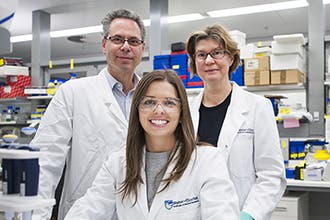Australian researchers have just found that an already existing medicine could show great promise in preventing breast cancer, especially for highly vulnerable women. If the findings are confirmed, they would provide a non-surgical option to prevent breast cancer in women with elevated genetic risk.

Professor Jane Visvader have discovered a potential new way
to prevent breast cancer in some at-risk women.
Women with a faulty BRCA1 gene are very vulnerable to breast cancer, but an existing drug called Denosumab may be able to help them. Denosumab is an antibody used or the treatment of osteoporosis, treatment-induced bone loss and giant cell tumor of bone, but it hasn’t been previously used to treat or prevent breast cancer.
Firstly, Ms Emma Nolan, Professor Jane Visvader and Professor Geoff Lindeman analyzed samples of breast tissue donated by women carrying a faulty BRCA1 gene. They were able to pinpoint the cells that gave birth to breast cancer.
“These cells proliferated rapidly, and were susceptible to damage to their DNA – both factors that help them transition towards cancer,” she said. “We were excited to discover that these pre-cancerous cells could be identified by a marker protein called RANK.”
Professor Lindeman, who is also a medical oncologist at The Royal Melbourne Hospital realized the importance of this finding – especially because commercial inhibitors of the RANK signaling pathway already exist.
“An inhibitor called denosumab is already used in the clinic to treat osteoporosis and breast cancer that has spread to the bone,” he said. “We therefore investigated what effect RANK inhibition had on the cancer precursor cells in BRCA1-mutant breast tissue.”
Their research then started focusing on how this could be done best, and what strategy would provide the most benefits to women at risk.
“This is potentially a very important discovery for women who carry a faulty BRCA1 gene, who have few other options. Current cancer prevention strategies for these women include surgical removal of the breasts and/or ovaries, which can have serious impacts on people’s lives. To progress this work, denosumab would need to be formally tested in clinical trials in this setting as it is not approved for breast cancer prevention,” Professor Lindeman said.
Professor Visvader underlined that this finding didn’t come from nowhere, but it’s rather the result of a decade of investigations of breast stem cell function.
“By thoroughly dissecting how normal breast tissue develops, we have been able to pinpoint the precise cells that are the culprits in cancer formation,” she said. “It is very exciting to think that we may be on the path to the ‘holy grail’ of cancer research, devising a way to prevent this type of breast cancer in women at high genetic risk.”






